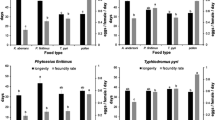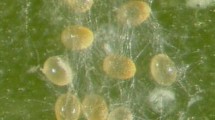Abstract
The phytoseiid mite, Amblyseius swirskii (Athias-Henriot) is an exotic biological control agent of mites and small insect pests in China. Amblyseius eharai (Amitai & Swirski), on the other hand, is a native predacious mite common throughout East and South-East Asia and considered to be an important natural enemy of Panonychus citri (McGregor). Understanding the ways introduced predators affect native ones is vital if we wish to use the former as biological control agents in the field. In order to evaluate the interactions between these two predacious mites, we observed their life histories when they cannibalized or fed upon intraguild prey under laboratory conditions. Both male and female A. eharai and A. swirskii could develop to adulthood by feeding upon both conspecific and heterospecific (IGP) eggs. However, A. swirskii females supplied with IGP eggs had shorter developmental durations, higher fecundity, and higher intrinsic rates of increase (r m ) than those supplied with conspecific eggs. On the other hand, A. eharai females supplied with conspecific eggs had higher r m than those supplied with heterospecific eggs, suggesting that A. eharai females may prefer to prey upon conspecific immatures, even when A. swirskii immature stages are present. As a result, A. swirskii females may decrease A. eharai populations, when extra-guild prey species, such as spider mites, and pollen are scarce.
Similar content being viewed by others
References
Brodeur J, Rosenheim JA (2000) Intraguild interactions in aphid parasitoids. Entomol Exp Appl 97:93–108
Buitenhuis R, Shipp L, Scott-Dupree C (2010) Intra-guild vs extra-guild prey: effect on predator fitness and preference of Amblyseius swirskii (Athias-Henriot) and Neoseiulus cucumeris (Oudemans) (Acari: Phytoseiidae). Bull Entomol Res 100:167–173
Cao HG, Yang ZQ, Gu ZL, Huang Z (1998) Phyllocoptruta oleivora Ashmead and its natural enemy. Acta Agric Jiangxi Univ 20:121–124
Chittenden AR, Saito Y (2001) Why are there feeding and non-feeding larvae in phytoseiid mites (Acari: Phytoseiidae)? J Ethol 19:55–62
Croft BA, Macrae IV (1993) Biological control of apple mites: impact of Zetzellia mali (Acari: Stigmaeidae) on Typhlodromus pyri and Metaseiulus occidentalis (Acari: Phytoseiidae). Environ Entomol 22:865–873
Duso C, Pasqualetto C, Camporese P (1991) Role of the predatory mites Amblyseius aberrans Oud., Typhlodromus pyri Scheuten and Amblyseius andersoni Chant (Acari, Phytoseiidae) in vineyards: II. Minimum releases of Amblyseius aberrans and Typhlodromus pyri to control spider mite populations (Acari, Tetranychidae). J Appl Entomol 112:298–308
Gotoh T, Hanawa M, Shimazaki S, Yokoyama N, Fu CQ, Sugawara R, Yano S (2014) Factors determining species displacement of related predatory mite species (Acari: Phytoseiidae). Exp Appl Acarol 63:205–215
Huang YB, Chi H (2012) Assessing the application of the jackknife and bootstrap techniques to the estimation of the variability of the net reproductive rate and gross reproductive rate: a case study in Bactrocera cucurbitae (Coquillett) (Diptera: Tephritidae). J Agric For 61:37–45
Ji J, Zhang ZQ, Zhang YX, Chen X, Lin JZ (2007) Effects of mating rates on oviposition, sex ratio and longevity in a predatory mite Neoseiulus cucumeris (Acari: Phytoseiidae). Exp Appl Acarol 43:171–180
Ji J, Zhang YX, Chen X, Lin JZ, Sun L (2012) The effect of repeated release of the predatory mite Neoseiulus (Amblyseius) curumeris on arthropod communities in citrus ecosystems. Biodivers Sci 20:24–31
Ji J, Lin T, Zhang YX, Lin JZ, Sun L, Chen X (2013a) A comparison between Amblyseius (Typhlodromips) swirskii and Amblyseius eharai with Panonychus citri (Acari: Tetranychidae) as prey: developmental duration, life table and predation. Syst Appl Acarol 18:123–129
Ji J, Lin T, Zhang YX, Sun L, Saito Y, Lin JZ, Chen X (2013b) Effects of starvation and humidity on the development and survival of Amblyseius swirskii, Agistemus exsertus and Amblyseius eharai. Syst Appl Acarol 18:321–328
Juan-Blasco M, Qureshi JA, Urbaneja A, Stansly PA (2012) Predatory mite, Amblyseius swirskii (Acari: Phytoseiidae), for biological control of Asian citrus psyllid, Diaphorina citri (Hemiptera: Psyllidae). Florida Entomol 95:543–551
Lee HS, Gillespie DR (2011) Life tables and development of Amblyseius swirskii (Acari: Phytoseiidae) at different temperatures. Exp Appl Acarol 53:17–27
McMurtry JA, De Moraes GJ, Sourassou NF (2013) Revision of the lifestyles of phytoseiid mites (Acari: Phytoseiidae) and implications for biological control strategies. Syst Appl Acarol 18:297–320
Momen FM, Abdel-khalek A (2009) Cannibalism and intraguild predation in the phytoseiid mites Typhlodromips swirskii, Euseius scutalis and Typhlodromus athiasae (Acari: Phytoseiidae). Acarina 17:223–229
Montserrat M, Janssen A, Magalhaes S, Sabelis MW (2006) To be an intraguild predator or a cannibal: is prey profitability decisive? Ecol Entomol 31:430–436
Nomikou M, Janssen A, Schraag R, Sabelis MW (2001) Phytoseiid predators as potential biological control agents for Bemisia tabaci. Exp Appl Acarol 25:271–291
Polis CA (1981) The evolution and dynamics of intraspecific predation. Annu Rev Ecol Syst 12:225–251
Polis GA, Myers CA, Holt RD (1989) The ecology and evolution of intraguild predation: potential competitors that eat each other. Annu Rev Ecol Sys 20:297–330
Saito Y, Mori H (1981) Parameters related to potential rate of population increase of three predacious mites in Japan (Acarina: Phytoseiidae). Appl Entomol Zool 16:45–47
Schausberger P (2003) Cannibalism among phytoseiid mites: a review. Exp Appl Acarol 29:173–191
Schausberger P (2005) The predatory mite Phytoseiulus persimilis manipulates imprinting among offspring through egg placement. Behav Ecol Sociobiol 58:53–59
Schausberger P, Croft BA (2000) Cannibalism and intraguild predation among phytoseiid mites: are aggressiveness and prey preference related to diet specialization? Exp Appl Acarol 24:709–725
Schausberger P, Croft BA (2001) Kin recognition and larval cannibalism by adult females in specialist predaceous mites. Anim Behav 61:459–464
Schausberger P, Walzer A (2001) Combined versus single species release of predaceous mites: predator-predator interactions and pest suppression. Biol Control 20:269–278
Toyoshima S, Amano H (1998) Effect of prey density on sex ratio of two predacious mites, Phytoseiulus persimilis and Amblyseius womersleyi (Acari: Phytoseiidae). Exp Appl Acarol 22:709–723
Xiao YF, Avery P, Chen JJ, McKenzie C, Osborne L (2012) Ornamental pepper as banker plants for establishment of Amblyseius swirskii (Acari: Phytoseiidae) for biological control of multiple pests in greenhouse vegetable production. Biol Control 63:279–286
Yang ZQ, Wang YL, Yang F, Zhang HR (1986) Studies on predatory mites catching harmful mites in citrus. Acta Agric Jiangxi Univ 8:81–84
Zannou ID, Hanna R (2011) Clarifying the identity of Amblyseius swirskii and Amblyseius rykei (Acari: Phytoseiidae): are they two distinct species or two populations of one species? Exp Appl Acarol 53:339–347
Zhang YX, Ji J, Lin JZ, Chen X, Saito Y (2014) Female performance towards offspring under starved conditions in four phytoseiid species (Acari, Phytoseiidae). Exp Appl Acarol. doi:10.1007/s10493-014-9847-2
Acknowledgments
We thank A. R. Chittenden who kindly edited the English usage. We also thank F. P. Zhang, L. L. Zhao, J. T. Lin and J. Chen for their help. This study was partly supported by the Science and Technology Innovation Team of Fujian Academy of Agricultural Sciences (CXTD-2-13-13), China Recruitment Program of Global Experts (Foreign Experts) (WQ20123500080), State Administration of Foreign Experts Affairs Key Project for Introduction of Foreign Expert (SZ2013003), Ministry of Agriculture Special Fund for Scientific Research in the Public Interest (201103020) and the 863 Program (2011AA10A201).
Author information
Authors and Affiliations
Corresponding author
Rights and permissions
About this article
Cite this article
Ji, J., Zhang, Y., Wang, J. et al. Can the predatory mites Amblyseius swirskii and Amblyseius eharai reproduce by feeding solely upon conspecific or heterospecific eggs (Acari: Phytoseiidae)?. Appl Entomol Zool 50, 149–154 (2015). https://doi.org/10.1007/s13355-014-0316-5
Received:
Accepted:
Published:
Issue Date:
DOI: https://doi.org/10.1007/s13355-014-0316-5




